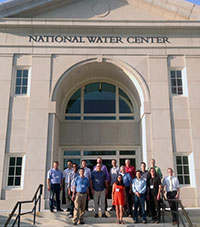UW receives funding in collaboration with National Water Center

The University of Wyoming will receive research and development funding from the National Water Center in exchange for the center harnessing a UW researcher’s water management model -- technology deemed vital to improving national weather and flood forecasting.
UW will receive research funding while the water center -- affiliated with the National Oceanographic and Atmospheric Administration-National Weather Service (NOAA-NWS), and based in Tuscaloosa, Ala. -- will use portions of the AdHydro Model developed by Fred Ogden, a UW professor in the Department of Civil and Architectural Engineering, and the Cline Endowed Chair of Engineering, Environment and Natural Resources.
ADHydro is a new quasi-3-D, large watershed simulator. The model was developed for computer operations on massive parallel supercomputing hardware to efficiently simulate large managed watersheds. ADHydro development is funded by the National Science Foundation (NSF) and Wyoming’s Experimental Program to Stimulate Competitive Research (EPSCoR).
“The collaboration of my model will be with the Water Research Forecasting (WRF)-Hydro model developed by NCAR,” Ogden explains. “It’s a framework to allow coupling of atmospheric models with hydrology models. NOAA’s vision is to incorporate the ADHydro model with the WRF-Hydro framework. They wisely realized one model doesn’t solve all problems.”
The AdHydro model will be able to adapt the WRF-Hydro model to provide higher resolution that will improve flood forecast modeling as storms move across the country, Ogden says.
“Certain weather service models don’t include water management,” he says. “Our model does include water management.”
This technology transfer is a “big milestone” for the EPSCoR Track II program, Ogden says. Wyoming EPSCoR is a program funded by the NSF to support researchers, students and institutions in Wyoming by building a robust and diverse research educational infrastructure in the state by supporting and facilitating programs. The program assists states that have historically received less NSF research and development funding.
“At this point, for us to be in a position to contribute to this new modeling activity, is a good place to be,” Ogden says. “We can thank NSF-EPSCoR for that. Without their funding, we wouldn’t be where we are today.”
Ogden will begin a one-year sabbatical Sept. 1 to conduct research at the National Water Center. In addition to a portion of his salary, Ogden says the center will provide funding for one Ph.D. computer scientist research member and two predoctoral researchers.
In early July, Ogden led a high-performance computing workshop, titled “High-Performance Computing in Hydrology: ADHydro Model Workshop,” at the National Water Center. The workshop was held in conjunction with the Third Consortium of Universities for the Advancement of Hydrologic Science (CUAHSI) Conference on Hydro informatics, and was attended by National Water Center staff, and graduate students from UW and other universities.
Ogden says his relationship with the National Water Center started about three years ago when that center’s director, Don Cline, pulled him aside after Ogden presented at a hydrology conference in Boulder, Colo. At that time, Cline relayed to him that the National Weather Service was interested in improving its forecasting methods and thought Ogden’s model held potential.
“As Don Cline has seen progress in our model development, the National Water Center has some very ambitious goals,” Ogden says. “Thanks to our team, we’ve developed this interesting, large-scale model. It incorporates our new novel method to simulate the vadose zone, a region in a part of the soil not saturated with water.”
Calculating the movement of water in the vadose zone is critical to everything from estimating return flows and aquifer recharge to better managing irrigation and predicting floods. But the traditional method used to calculate vadose zone flows, Richard’s equation, is extremely difficult to solve, and occasionally unsolvable. So, while some high-powered supercomputer models can handle it over small geographic areas, simpler models or those covering large regions must use approximations that compromise accuracy.
Ogden and his research team, however, recently made a discovery that answers a nearly 100-year-old question about calculating water movement in soils, with implications for agriculture, hydrology, climate science and other fields. Ogden and his research team discovered a novel solution, an elegant new equation that he thought would equal the Richards equation (it calculates how much water makes it into soil over time as rainfall hits the ground surface and filters down toward the water table) in accuracy while greatly reducing the computing power needed to run it. He tested this solution with precipitation data from his field site in Panama.
This finding lies at the heart of the ADHydro model, and gives it capabilities that no other hydrologic model now has.
“To be in a position to take advantage of work we’ve done is a good position to be in,” he says.
